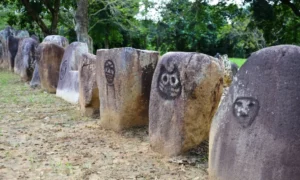The Caguana Ceremonial Ball Courts Site, located in the central highlands of Puerto Rico, is a significant archaeological site. It showcases the pre-Columbian history of the Caribbean. The site contains several stone-lined ball courts, petroglyphs, and plazas. It offers a glimpse into the lives and rituals of the Taíno people, the indigenous inhabitants of the region. The Taíno culture was vibrant and complex, with Caguana being a focal point for ceremonial activities and community gatherings.
The Taíno
The Taíno were a group of Arawak-speaking people who were among the indigenous populations of the Caribbean at the time of Columbus’s arrival in 1492. Originating from the Orinoco region in South America, they migrated through the Lesser Antilles and into the Greater Antilles and the Bahamas, establishing themselves as the dominant culture in these regions by around AD 1000. The Taíno civilization was characterized by its agricultural practices, fishing, and hunting techniques, which were adapted to the island environments they inhabited.
The Taíno society was organized into a hierarchical structure with caciques (chiefs) at the top, who wielded considerable power and influence. These caciques were often male, but there are records of female caciques as well, indicating a level of gender flexibility in leadership roles. The caciques ruled over yucayeques (villages) and were responsible for the welfare of their communities, including the allocation of land and resources. They were also pivotal in maintaining the spiritual and social cohesion of the group through various ceremonies and rituals.
Religion played a central role in Taíno society, with a pantheon of gods (zemis) who governed natural elements and human affairs. The Taíno believed in the importance of maintaining a balance with nature and performed various ceremonies to honor their gods, including areitos (ceremonial dances), and the use of cohoba, a hallucinogenic substance, to communicate with the spiritual realm. Cemí idols, carved representations of their gods, were venerated objects that held significant religious power.
Daily life for the Taíno revolved around their villages, which were typically situated near fertile land and water sources. Their diet was primarily based on agriculture, with cassava (manioc) being the staple crop, complemented by maize, beans, squash, and fruits. Fishing and hunting also provided a substantial portion of their diet. The Taíno were skilled craftsmen, creating pottery, baskets, and cotton textiles, which were used in daily life and trade.
The arrival of Christopher Columbus in 1492 marked the beginning of a tragic period for the Taíno, as the Spanish colonization of the Americas brought diseases, enslavement, and warfare, which decimated their population. Despite initial attempts to resist, such as the rebellion led by the cacique Enriquillo in the early 16th century, the Taíno were unable to withstand the combined effects of disease and colonial oppression. By the end of the 16th century, the Taíno were considered by the Spanish to be largely extinct, though some survived by fleeing to remote areas or intermixing with Spanish and African populations.
The legacy of the Taíno is still evident today in the Caribbean, not only in genetic contributions to the populations of the region but also in the survival of Taíno words, agricultural practices, and artisanal techniques. The Taíno language has contributed numerous words to Spanish and other languages, including “hurricane” (from the Taíno storm god, Juracán) and “barbecue” (from the Taíno word barbacoa).
In recent years, there has been a resurgence of interest in Taíno culture and identity, with some Caribbean people claiming Taíno ancestry and seeking to revive and preserve Taíno traditions and knowledge. This movement has been supported by archaeological and genetic research that has provided a clearer understanding of Taíno history and the impact of European colonization.
The Taíno civilization, with its rich culture, sophisticated social organization, and profound spiritual beliefs, represents a significant chapter in the history of the Caribbean. Despite the devastating impact of European colonization, the resilience of the Taíno people and their enduring legacy continue to be celebrated and explored, offering insights into the complex tapestry of human history in the Americas.

